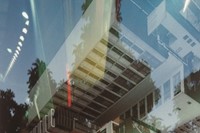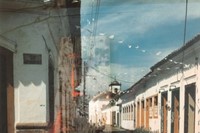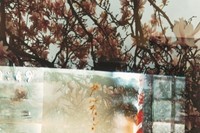As an exhibition displaying the works of Gozo Yoshimasu opens in London, AnOther looks at the life and work of the acclaimed Japanese cultural figure
Who? Gozo Yoshimasu has been hailed as one of the most significant figures in Japanese art and literature. Born and raised in Tokyo, he first found notice on the literary scene in the 1960s, with his critically acclaimed book, Departure. Throughout the 1980s, Yoshimasu grew to greater prominence and became known for his polyphonic poetry. He explores the Japanese language – which uses hiragana and katakana, two phonetic sign systems – and the Japanese pronunciation system, kanji, to craft words with infinite possibilities. His poetry is often bilingual, allowing him to experiment with typographic wordplay.
What? Most evocative are Yoshimasu’s weightless photographic double exposures. The title of Yoshimasu's exhibition at the Daiwa Anglo-Japanese Foundation in London, As Though Tattooing on my Mind, explains much about his work. In his photographs, he jostles images of memory, so that the result is one of flux. Reality, desire and melancholy all mingle; we are looking at existential dreamscapes or a lost scene through the fallible prism of remembrance.

“The double exposure is the best of all the visual techniques to represent the dream, for it exceeds time and space, and allows the melting of heterogeneous subjects into a coherent whole.” So said Hungarian photographer László Moholy-Nagy, over a century ago. Indeed Yoshimasu experiments with the tradition of double exposure photography to the same end. His images – of petals, people, woodland and urban scenes – play with luminous surfaces and ripples of light through soft focus and panoramic perspective.
Why? Yoshimasu’s visual artworks on display include copper plate engravings, video work and manuscript through which he expresses his poetry. His art draws on the ancient and beautiful tradition of Japanese calligraphy, which appears across the works. His visual-poetry series on display, Kaibutsu-kun: Dear Monster, explores his response to the Tohoku earthquake and tsunami in 2001, whilst his film series, gozoCiné, pushes the boundaries of audio-visual poetry.
As Though Tattooing on my Mind is at the Daiwa Anglo-Japanese Foundation until May 13.



